A design method of digital signature scheme based on discrete logarithm problem
In 1985, T. ElGamal [l] proposed the digital signature
scheme based on the discrete logarithm problem. Then, in
1989, C.P. Schnorr [2] proposed an efficient signature
scheme to shorten the length of the signature and to speed
up the signature generation/verification process, and in
1991, the NIST (National Institute of Standards and
Technology) proposed the Digital Signature Algorithm
(DSA) [3] for the digital signature standard based on
ElGamal and Schnorr signature schemes. Currently, the
digital signature has been widely applied in e-government,
e-commerce . in the world and initially deployed in
Vietnam. Therefore, it is required to be set out the digital
signature scheme research - development to design -
manufacture new products, safe equipment and
information security in countries such as Vietnam. This
paper proposes a construction method of digital signature
scheme based on the difficulty of the discrete logarithm
problem by generalizing ElGamal and Schnorr’s method,
and some digital signature schemes have been developed
based on this method.
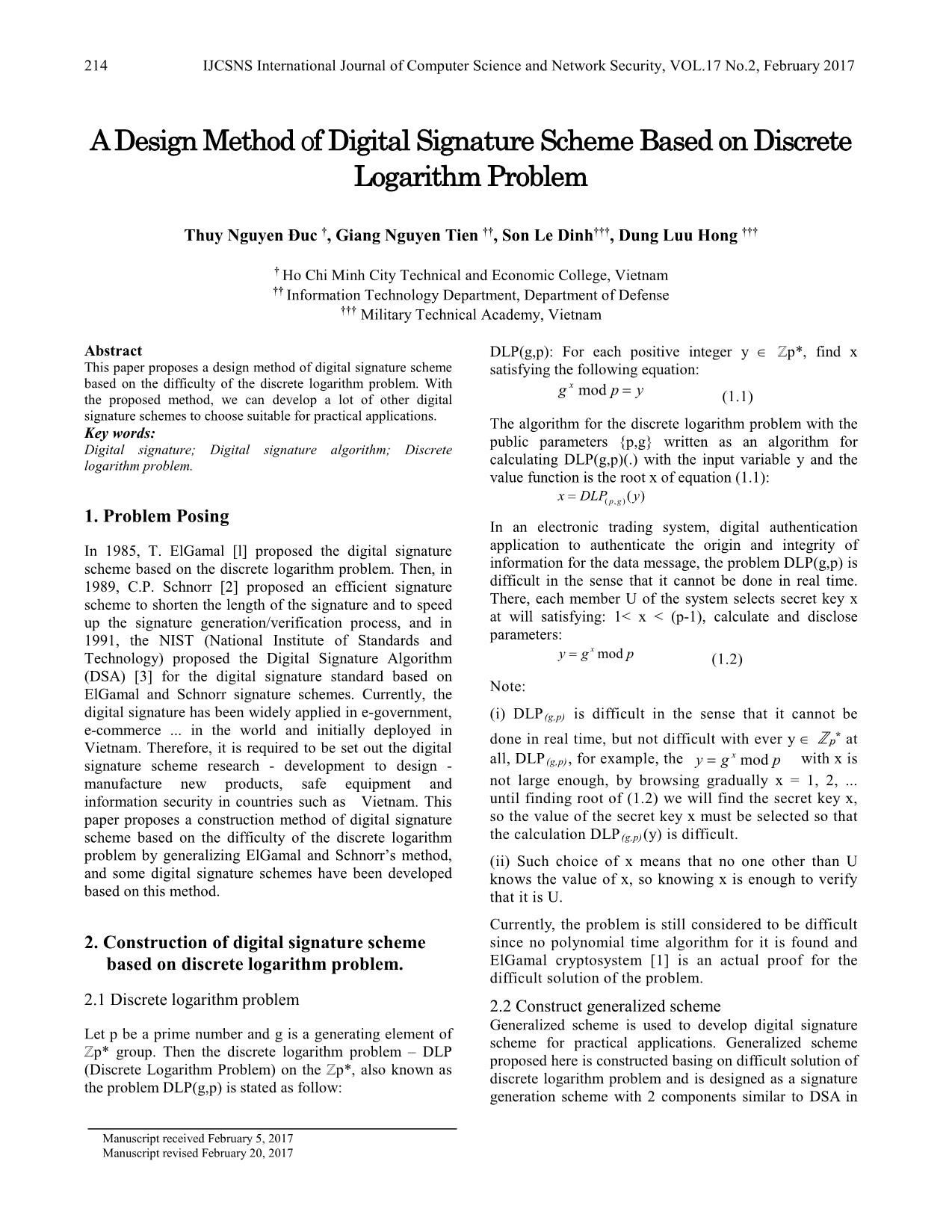
Trang 1
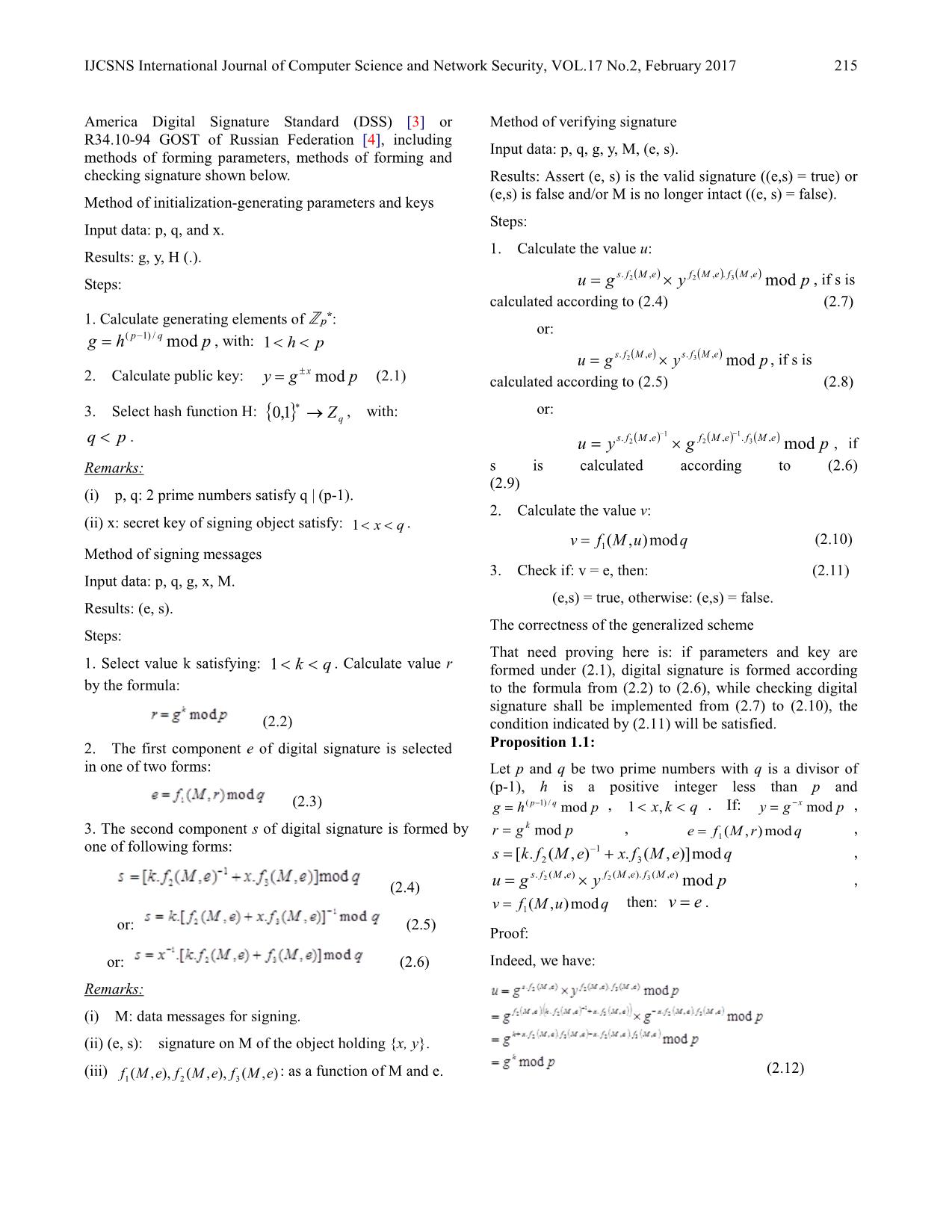
Trang 2
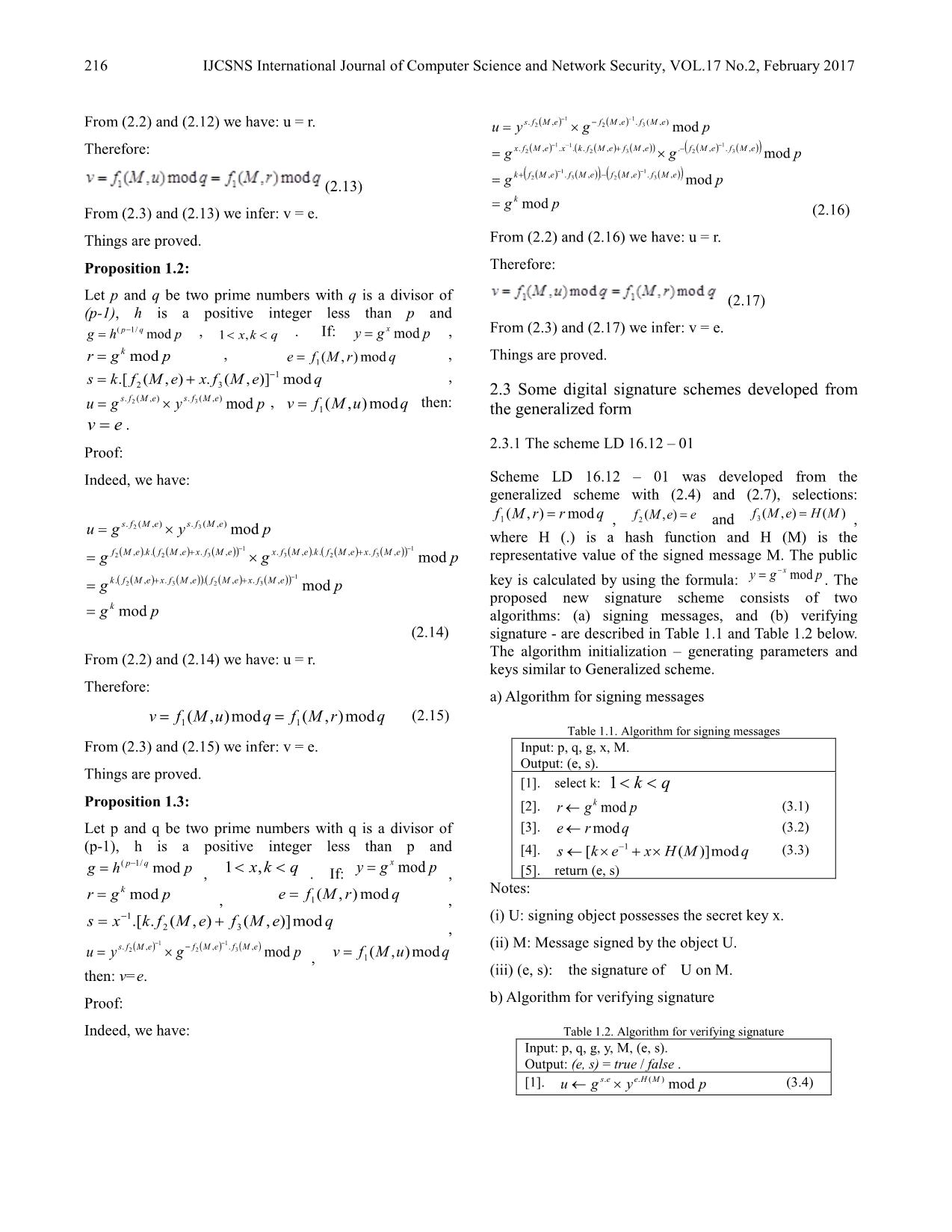
Trang 3
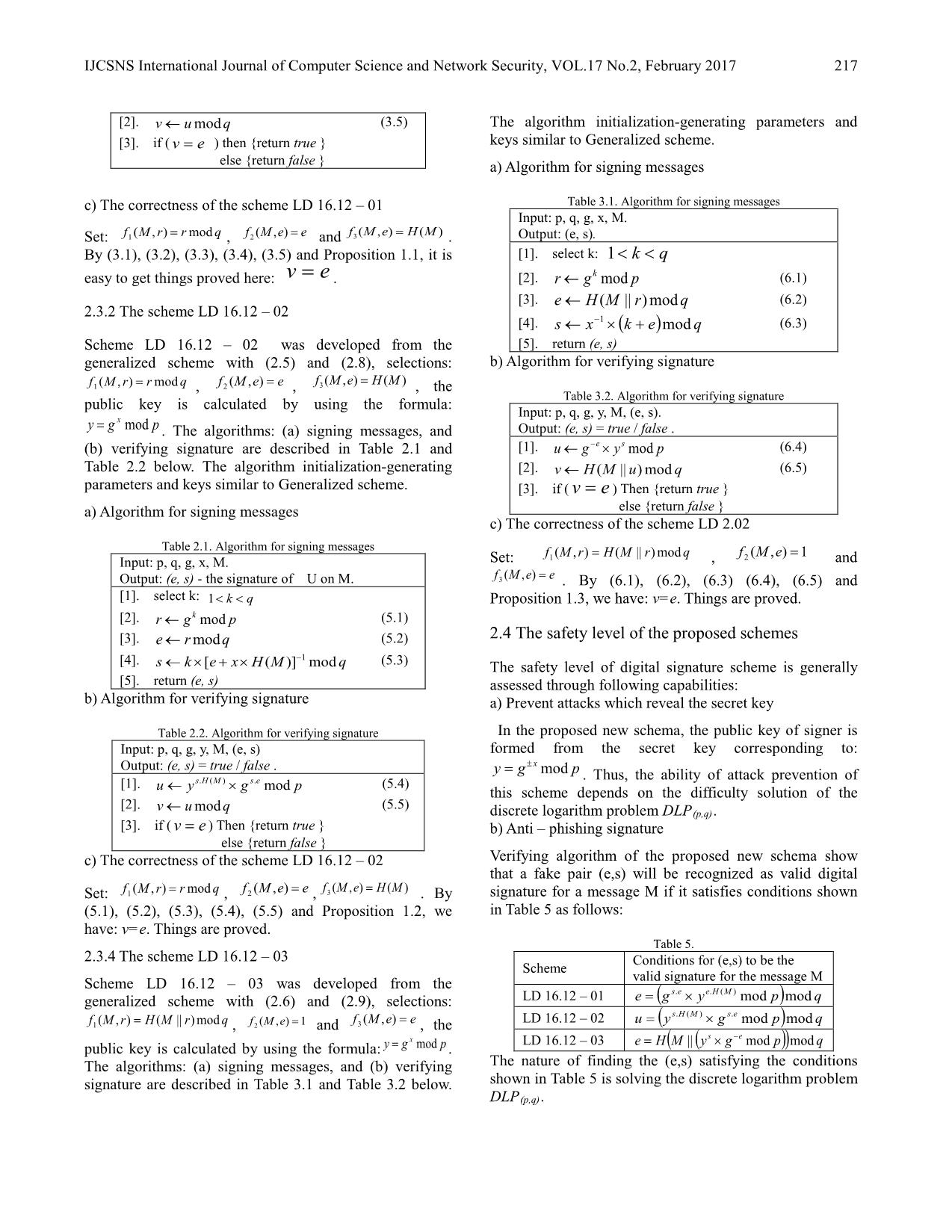
Trang 4
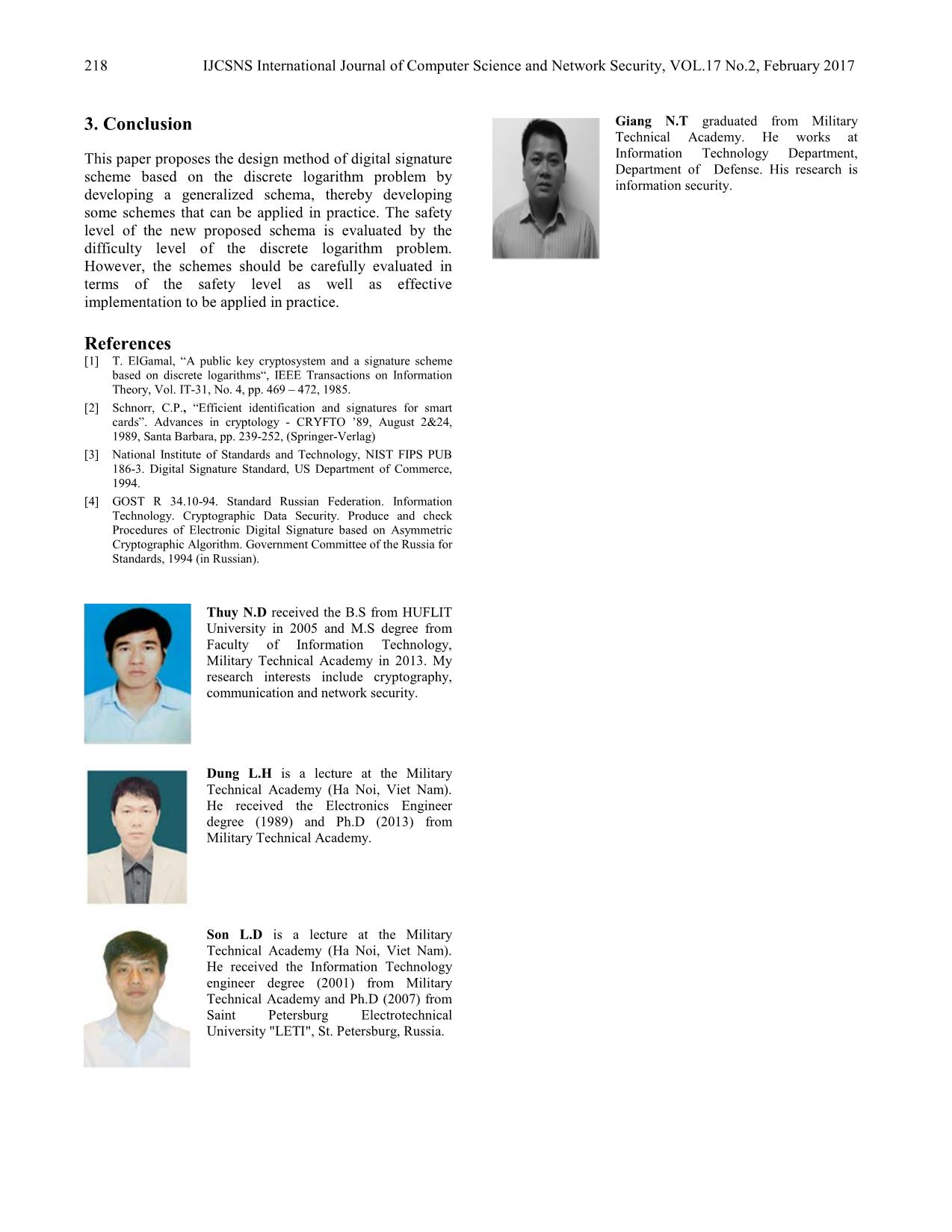
Trang 5
Tóm tắt nội dung tài liệu: A design method of digital signature scheme based on discrete logarithm problem
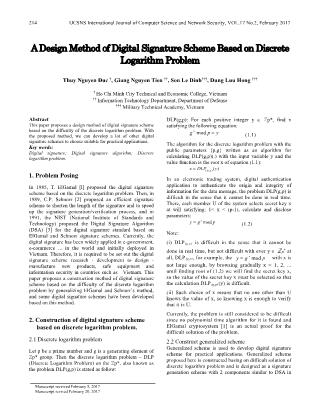
IJCSNS International Journal of Computer Science and Network Security, VOL.17 No.2, February 2017
214
Manuscript received February 5, 2017
Manuscript revised February 20, 2017
A Design Method of Digital Signature Scheme Based on Discrete
Logarithm Problem
Thuy Nguyen Đuc †, Giang Nguyen Tien ††, Son Le Dinh†††, Dung Luu Hong †††
† Ho Chi Minh City Technical and Economic College, Vietnam
†† Information Technology Department, Department of Defense
††† Military Technical Academy, Vietnam
Abstract
This paper proposes a design method of digital signature scheme
based on the difficulty of the discrete logarithm problem. With
the proposed method, we can develop a lot of other digital
signature schemes to choose suitable for practical applications.
Key words:
Digital signature; Digital signature algorithm; Discrete
logarithm problem.
1. Problem Posing
In 1985, T. ElGamal [l] proposed the digital signature
scheme based on the discrete logarithm problem. Then, in
1989, C.P. Schnorr [2] proposed an efficient signature
scheme to shorten the length of the signature and to speed
up the signature generation/verification process, and in
1991, the NIST (National Institute of Standards and
Technology) proposed the Digital Signature Algorithm
(DSA) [3] for the digital signature standard based on
ElGamal and Schnorr signature schemes. Currently, the
digital signature has been widely applied in e-government,
e-commerce ... in the world and initially deployed in
Vietnam. Therefore, it is required to be set out the digital
signature scheme research - development to design -
manufacture new products, safe equipment and
information security in countries such as Vietnam. This
paper proposes a construction method of digital signature
scheme based on the difficulty of the discrete logarithm
problem by generalizing ElGamal and Schnorr’s method,
and some digital signature schemes have been developed
based on this method.
2. Construction of digital signature scheme
based on discrete logarithm problem.
2.1 Discrete logarithm problem
Let p be a prime number and g is a generating element of
ℤp* group. Then the discrete logarithm problem – DLP
(Discrete Logarithm Problem) on the ℤp*, also known as
the problem DLP(g,p) is stated as follow:
DLP(g,p): For each positive integer y ∈ ℤp*, find x
satisfying the following equation:
ypg x =mod (1.1)
The algorithm for the discrete logarithm problem with the
public parameters {p,g} written as an algorithm for
calculating DLP(g,p)(.) with the input variable y and the
value function is the root x of equation (1.1):
)(),( yDLPx gp=
In an electronic trading system, digital authentication
application to authenticate the origin and integrity of
information for the data message, the problem DLP(g,p) is
difficult in the sense that it cannot be done in real time.
There, each member U of the system selects secret key x
at will satisfying: 1< x < (p-1), calculate and disclose
parameters:
pgy x mod= (1.2)
Note:
(i) DLP (g,p) is difficult in the sense that it cannot be
done in real time, but not difficult with ever y ∈ ℤp* at
all, DLP (g,p) , for example, the pgy x mod= with x is
not large enough, by browsing gradually x = 1, 2, ...
until finding root of (1.2) we will find the secret key x,
so the value of the secret key x must be selected so that
the calculation DLP (g,p)(y) is difficult.
(ii) Such choice of x means that no one other than U
knows the value of x, so knowing x is enough to verify
that it is U.
Currently, the problem is still considered to be difficult
since no polynomial time algorithm for it is found and
ElGamal cryptosystem [1] is an actual proof for the
difficult solution of the problem.
2.2 Construct generalized scheme
Generalized scheme is used to develop digital signature
scheme for practical applications. Generalized scheme
proposed here is constructed basing on difficult solution of
discrete logarithm problem and is designed as a signature
generation scheme with 2 components similar to DSA in
IJCSNS International Journal of Computer Science and Network Security, VOL.17 No.2, February 2017
215
America Digital Signature Standard (DSS) [3] or
R34.10-94 GOST of Russian Federation [4], including
methods of forming parameters, methods of forming and
checking signature shown below.
Method of initialization-generating parameters and keys
Input data: p, q, and x.
Results: g, y, H (.).
Steps:
1. Calculate generating elements of ℤp*:
phg qp mod/)1( −= , with: ph <<1
2. Calculate public key: pgy x mod±= (2.1)
3. Select hash function H: { } qZ→∗1,0 , with:
pq < .
Remarks:
(i) p, q: 2 prime numbers satisfy q | (p-1).
(ii) x: secret key of signing object satisfy: qx <<1 .
Method of signing messages
Input data: p, q, g, x, M.
Results: (e, s).
Steps:
1. Select value k satisfying: qk <<1 . Calculate value r
by the formula:
(2.2)
2. The first component e of digital signature is selected
in one of two forms:
(2.3)
3. The second component s of digital signature is formed by
one of following forms:
(2.4)
or: (2.5)
or: (2.6)
Remarks:
(i) M: data messages for signing.
(ii) (e, s): signature on M of the object holding {x, y}.
(iii) ),(),,(),,( 321 eMfeMfeMf : as a function of M and e.
Method of verifying signature
Input data: p, q, g, y, M, (e, s).
Results: Assert (e, s) is the valid signature ((e,s) = true) or
(e,s) is false and/or M is no longer intact ((e, s) = false).
Steps:
1. Calculate the value u:
( ) ( ) ( ) pygu eMfeMfeMfs mod,.,,. 322 ×= , if s is
calculated according to (2.4) (2.7)
or:
( ) ( ) pygu eMfseMfs mod,.,. 32 ×= , if s is
calculated according to (2.5) (2.8)
or:
( ) ( ) ( ) pgyu eMfeMfeMfs mod,.,,. 3
1
2
1
2
−−
×= , if
s is calculated according to (2.6)
(2.9)
2. Calculate the value v:
quMfv mod),(1= (2.10)
3. Check if: v = e, then: (2.11)
(e,s) = true, otherwise: (e,s) = false.
The correctness of the generalized scheme
That need proving here is: if parameters and key are
formed under (2.1), digital signature is formed according
to the formula from (2.2) to (2.6), while checking digital
signature shall be implemented from (2.7) to (2.10), the
condition indicated by (2.11) will be satisfied.
Proposition 1.1:
Let p and q be two prime numbers with q is a divisor of
(p-1), h is a positive integer less than p and
phg qp mod/)1( −= , qkx << ,1 . If: pgy
x mod−= ,
pgr k mod= , qrMfe mod),(1= ,
qeMfxeMfks mod)],(.),(.[ 3
1
2 +=
− ,
pygu eMfeMfeMfs mod),().,(),(. 322 ×= ,
quMfv mod),(1= then: ev = .
Proof:
Indeed, we have:
(2.12)
IJCSNS International Journal of Computer Science and Network Security, VOL.17 No.2, February 2017
216
From (2.2) and (2.12) we have: u = r.
Therefore:
(2.13)
From (2.3) and (2.13) we infer: v = e.
Things are proved.
Proposition 1.2:
Let p and q be two prime numbers with q is a divisor of
(p-1), h is a positive integer less than p and
phg qp mod/1( −= , qkx << ,1 . If: pgy x mod= ,
pgr k mod= , qrMfe mod),(1= ,
qeMfxeMfks mod)],(.),(.[ 132
−+= ,
pygu eMfseMfs mod),(.),(. 32 ×= , quMfv mod),(1= then:
ev = .
Proof:
Indeed, we have:
( ) ( ) ( )( ) ( ) ( ) ( )( )
( ) ( )( ) ( ) ( )( )
pg
pg
pgg
pygu
k
eMfxeMfeMfxeMfk
eMfxeMfkeMfxeMfxeMfkeMf
eMfseMfs
mod
mod
mod
mod
1
3232
1
323
1
322
32
,.,.,.,.
,.,..,.,.,..,
),(.),(.
=
=
×=
×=
−
−−
++
++
(2.14)
From (2.2) and (2.14) we have: u = r.
Therefore:
qrMfquMfv mod),(mod),( 11 == (2.15)
From (2.3) and (2.15) we infer: v = e.
Things are proved.
Proposition 1.3:
Let p and q be two prime numbers with q is a divisor of
(p-1), h is a positive integer less than p and
phg qp mod/1( −= , qkx << ,1 . If: pgy
x mod= ,
pgr k mod= , qrMfe mod),(1= ,
qeMfeMfkxs mod)],(),(..[ 32
1 += − ,
( ) ( ) ( ) pgyu eMfeMfeMfs mod,.,,. 3
1
2
1
2
−− −×= , quMfv mod),(1=
then: v=e.
Proof:
Indeed, we have:
( ) ( )
( ) ( ) ( )( ) ( ) ( )( )
( ) ( )( ) ( ) ( )( )
pg
pg
pgg
pgyu
k
eMfeMfeMfeMfk
eMfeMfeMfeMfkxeMfx
eMfeMfeMfs
mod
mod
mod
mod
,.,.,.,
,.,.,,...,.
),(.,,.
3
1
23
1
2
3
1
232
11
2
3
1
2
1
2
=
=
×=
×=
−−
−−−
−−
−+
−+
−
(2.16)
From (2.2) and (2.16) we have: u = r.
Therefore:
(2.17)
From (2.3) and (2.17) we infer: v = e.
Things are proved.
2.3 Some digital signature schemes developed from
the generalized form
2.3.1 The scheme LD 16.12 – 01
Scheme LD 16.12 – 01 was developed from the
generalized scheme with (2.4) and (2.7), selections:
qrrMf mod),(1 = , eeMf =),(2 and )(),(3 MHeMf = ,
where H (.) is a hash function and H (M) is the
representative value of the signed message M. The public
key is calculated by using the formula: pgy
x mod−= . The
proposed new signature scheme consists of two
algorithms: (a) signing messages, and (b) verifying
signature - are described in Table 1.1 and Table 1.2 below.
The algorithm initialization – generating parameters and
keys similar to Generalized scheme.
a) Algorithm for signing messages
Table 1.1. Algorithm for signing messages
Input: p, q, g, x, M.
Output: (e, s).
[1]. select k: qk <<1
[2]. pgr k mod← (3.1)
[3]. qre mod← (3.2)
[4]. qMHxeks mod)]([ 1 ×+×← − (3.3)
[5]. return (e, s)
Notes:
(i) U: signing object possesses the secret key x.
(ii) M: Message signed by the object U.
(iii) (e, s): the signature of U on M.
b) Algorithm for verifying signature
Table 1.2. Algorithm for verifying signature
Input: p, q, g, y, M, (e, s).
Output: (e, s) = true / false .
[1]. pygu MHees mod)(.. ×← (3.4)
IJCSNS International Journal of Computer Science and Network Security, VOL.17 No.2, February 2017
217
[2]. quv mod← (3.5)
[3]. if ( ev = ) then {return true }
else {return false }
c) The correctness of the scheme LD 16.12 – 01
Set: qrrMf mod),(1 = , eeMf =),(2 and )(),(3 MHeMf = .
By (3.1), (3.2), (3.3), (3.4), (3.5) and Proposition 1.1, it is
easy to get things proved here: ev = .
2.3.2 The scheme LD 16.12 – 02
Scheme LD 16.12 – 02 was developed from the
generalized scheme with (2.5) and (2.8), selections:
qrrMf mod),(1 = , eeMf =),(2 , )(),(3 MHeMf = , the
public key is calculated by using the formula:
pgy x mod= . The algorithms: (a) signing messages, and
(b) verifying signature are described in Table 2.1 and
Table 2.2 below. The algorithm initialization-generating
parameters and keys similar to Generalized scheme.
a) Algorithm for signing messages
Table 2.1. Algorithm for signing messages
Input: p, q, g, x, M.
Output: (e, s) - the signature of U on M.
[1]. select k: qk <<1
[2]. pgr k mod← (5.1)
[3]. qre mod← (5.2)
[4]. qMHxeks mod)]([ 1−×+×← (5.3)
[5]. return (e, s)
b) Algorithm for verifying signature
Table 2.2. Algorithm for verifying signature
Input: p, q, g, y, M, (e, s)
Output: (e, s) = true / false .
[1]. pgyu esMHs mod.)(. ×← (5.4)
[2]. quv mod← (5.5)
[3]. if ( ev = ) Then {return true }
else {return false }
c) The correctness of the scheme LD 16.12 – 02
Set: qrrMf mod),(1 = , eeMf =),(2 , )(),(3 MHeMf = . By
(5.1), (5.2), (5.3), (5.4), (5.5) and Proposition 1.2, we
have: v=e. Things are proved.
2.3.4 The scheme LD 16.12 – 03
Scheme LD 16.12 – 03 was developed from the
generalized scheme with (2.6) and (2.9), selections:
qrMHrMf mod)||(),(1 = , 1),(2 =eMf and eeMf =),(3 , the
public key is calculated by using the formula: pgy
x mod= .
The algorithms: (a) signing messages, and (b) verifying
signature are described in Table 3.1 and Table 3.2 below.
The algorithm initialization-generating parameters and
keys similar to Generalized scheme.
a) Algorithm for signing messages
Table 3.1. Algorithm for signing messages
Input: p, q, g, x, M.
Output: (e, s).
[1]. select k: qk <<1
[2]. pgr k mod← (6.1)
[3]. qrMHe mod)||(← (6.2)
[4]. ( ) qekxs mod1 +×← − (6.3)
[5]. return (e, s)
b) Algorithm for verifying signature
Table 3.2. Algorithm for verifying signature
Input: p, q, g, y, M, (e, s).
Output: (e, s) = true / false .
[1]. pygu se mod×← − (6.4)
[2]. quMHv mod)||(← (6.5)
[3]. if ( ev = ) Then {return true }
else {return false }
c) The correctness of the scheme LD 2.02
Set: qrMHrMf mod)||(),(1 = , 1),(2 =eMf and
eeMf =),(3 . By (6.1), (6.2), (6.3) (6.4), (6.5) and
Proposition 1.3, we have: v=e. Things are proved.
2.4 The safety level of the proposed schemes
The safety level of digital signature scheme is generally
assessed through following capabilities:
a) Prevent attacks which reveal the secret key
In the proposed new schema, the public key of signer is
formed from the secret key corresponding to:
pgy x mod±= . Thus, the ability of attack prevention of
this scheme depends on the difficulty solution of the
discrete logarithm problem DLP(p,q).
b) Anti – phishing signature
Verifying algorithm of the proposed new schema show
that a fake pair (e,s) will be recognized as valid digital
signature for a message M if it satisfies conditions shown
in Table 5 as follows:
Table 5.
Scheme Conditions for (e,s) to be the valid signature for the message M
LD 16.12 – 01 ( ) qpyge MHees modmod)(.. ×=
LD 16.12 – 02 ( ) qpgyu esMHs modmod.)(. ×=
LD 16.12 – 03 ( )( ) qpgyMHe es modmod|| −×=
The nature of finding the (e,s) satisfying the conditions
shown in Table 5 is solving the discrete logarithm problem
DLP(p,q).
IJCSNS International Journal of Computer Science and Network Security, VOL.17 No.2, February 2017
218
3. Conclusion
This paper proposes the design method of digital signature
scheme based on the discrete logarithm problem by
developing a generalized schema, thereby developing
some schemes that can be applied in practice. The safety
level of the new proposed schema is evaluated by the
difficulty level of the discrete logarithm problem.
However, the schemes should be carefully evaluated in
terms of the safety level as well as effective
implementation to be applied in practice.
References
[1] T. ElGamal, “A public key cryptosystem and a signature scheme
based on discrete logarithms“, IEEE Transactions on Information
Theory, Vol. IT-31, No. 4, pp. 469 – 472, 1985.
[2] Schnorr, C.P., “Efficient identification and signatures for smart
cards”. Advances in cryptology - CRYFTO ’89, August 2&24,
1989, Santa Barbara, pp. 239-252, (Springer-Verlag)
[3] National Institute of Standards and Technology, NIST FIPS PUB
186-3. Digital Signature Standard, US Department of Commerce,
1994.
[4] GOST R 34.10-94. Standard Russian Federation. Information
Technology. Cryptographic Data Security. Produce and check
Procedures of Electronic Digital Signature based on Asymmetric
Cryptographic Algorithm. Government Committee of the Russia for
Standards, 1994 (in Russian).
Thuy N.D received the B.S from HUFLIT
University in 2005 and M.S degree from
Faculty of Information Technology,
Military Technical Academy in 2013. My
research interests include cryptography,
communication and network security.
Dung L.H is a lecture at the Military
Technical Academy (Ha Noi, Viet Nam).
He received the Electronics Engineer
degree (1989) and Ph.D (2013) from
Military Technical Academy.
Son L.D is a lecture at the Military
Technical Academy (Ha Noi, Viet Nam).
He received the Information Technology
engineer degree (2001) from Military
Technical Academy and Ph.D (2007) from
Saint Petersburg Electrotechnical
University "LETI", St. Petersburg, Russia.
Giang N.T graduated from Military
Technical Academy. He works at
Information Technology Department,
Department of Defense. His research is
information security.
File đính kèm:
 a_design_method_of_digital_signature_scheme_based_on_discret.pdf
a_design_method_of_digital_signature_scheme_based_on_discret.pdf

